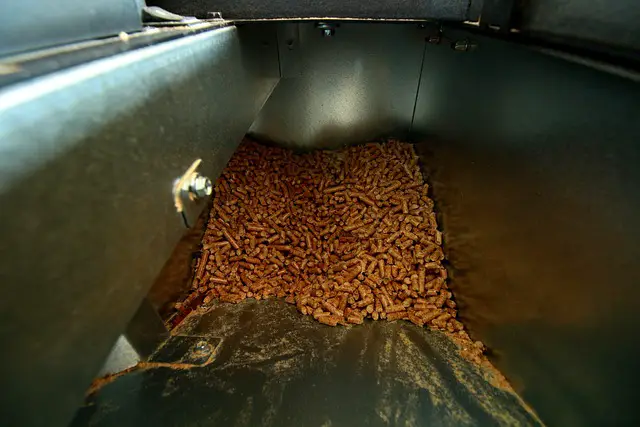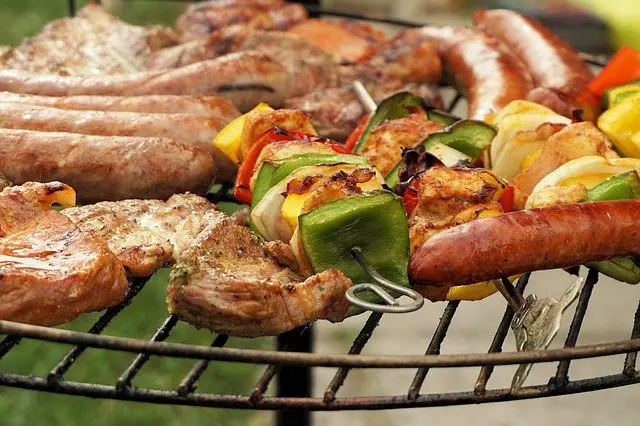Pellet grills have become a force to reckon with in the world of outdoor cooking in recent years because they managed to infuse the flavors of a charcoal grill or smoker with the efficiency of gas or electric smokers and grills. Their versatility can instantly make you the backyard champion of grilling, smoking, or even baking among friends and family without having to break the bank.
We will break down their cooking process to understand how pellet grills work to deliver savory meals so you can use different preparation methods with consistently excellent results. This article also highlights the benefits of using a pellet grill, how they come about and how to optimize them. Let’s start by addressing the main question.
How Does a Pellet Grill Work?
- The pellets are fed by gravity from the grill’s hopper to the auger
- The electrically controlled rotating auger pushes the required amount of pellets towards the fire pot. The faster it rotates, the more fuel is added, the hotter the cooking chamber becomes. It stops feeding the fire once the required temperature has been attained in the chamber.
- The pellets drop into the fire pot, where they encounter a hot rod that ignites them and starts the combustion process.
- A fan blows in air to stroke the flame and intensify the fire. It also circulates the resulting heat and smoke for even distribution and consistency in cooking. The higher the velocity of the fan, the more intense the resulting heat and vice versa.
- The grill requires some time for the cooking chamber to heat up to the required temperature. Allow it to get to this level before introducing your food for the best results. This temperature is preset based on what you are cooking and the method you intend to use.
- The heat and wood smoke travel upwards to baste your food, adding that delicious smoky wood flavor in the process.
- Most pellet grills have a heat plate that deflects the heat and smoke to evenly distribute it throughout the grill. It also helps to avoid flare-ups, keeping the flame away from the food and preventing charring.
- An electric controller manages the functions, which turns on the hot rod and regulates the heat based on your settings and temperature readings.
- The drip tray has a waste management system that carries the drippings to a removable grease tray for easy cleaning.
Key Components of a Pellet Grill
Let’s look at how each part of these outdoor cookers contributes to the overall functioning of the grill.
Pellets

This is the fuel consumed in a pellet grill to produce the heat that will be used in cooking. They are often blended to provide customized flavors on top of the smoky taste. Common flavors include chicory, apple, or mesquite.
You can use wood pellets or wood chips in your wood pellet grill or smoker. These are cost-effective choices and are used for this purpose because they were not treated with any unnatural substances, making them safe for cooking. They also give your food that great smoky flavor you want.
The flavors hit different depending on the type of food being prepared; you will not have the same effect on beef as you would on pork, poultry, or seafood. Veggies are also different, and you may need to tinker with different flavors before you get the perfect combinations.
Quality smoking pellets are made from hardwood with no artificial binding agents to ensure they are food grade. The number of hardwood pellets you burn through will depend on the temperature at which you are cooking and the duration of the cycle. The higher the temperature required and the longer your cooking cycle, the more fuel will be consumed by your pellet smoker or grill, and the more wood smoke you produce.
For barbecue pellet fuel, you can also consider compressed sawdust. Traeger actually makes compressed sawdust hardwood pellets that can serve as the fuel of choice for a pellet barbecue grill.
Cookbox/Cooking Chamber
This is the enclosure in which your food is prepared during the pellet grilling process. The conditions in this space determine how the food will turn out, and the entire grill is designed to optimize this.
Hot Rod
It is the electric starter that gets red hot and ignites the pellets. It stops once the flame lights up, letting the fire grow through the pellets.
Fan
It regulates airflow and the rate of combustion. Increasing its intensity raises the combustion rate
Auger
It is a part of the grill fashioned like a large corkscrew that turns and feeds fuel. It keeps dropping pellets into the burn pot to feed the fire depending on the need.
Electronic Controller
The pellet grill’s driver, the electronic controller tells the hot rod when to ignite the fuel and turns off the grill at the end of the cooking cycle. It also monitors the temperature inside the cookbox and manipulates the fan and auger to regulate the heat based on temperature readings from the cookbox probe and your settings.
It is the reason you can focus on other things and leave the pellet grill cooking without supervision. This is why a pellet grill can be used for baking; it is possible to maintain a constant temperature throughout the cooking process, just like your regular oven.
Besides baking, you can smoke, roast, braise, and barbeque on a pellet grill. Although it doesn’t achieve the high temperatures of a charcoal or propane gas grill, it grills at a lower, more even temperature, allowing the flavors to sink in fully. It will take a lot of effort to sear because this happens at approximately 550˚F, which is on the higher side for pellet grilling.
Fortunately, modern grills have enhanced capacities ranging from 200 to 600˚F, which is sufficient for all your cooking needs. You can sample this selection of quality pellet grills best small pellet grill article for some of the best deals.

Maintenance
Wood pellets and wood chips can easily absorb water and expand, which is why fresh hardwood pellets burn better than those that have been outside for days. The quality of fuel affects how the pellet grills work and the flavors the pellets facilitate.
Outdoor cookers should be stored well and protected from any contact with moisture. Avoid leaving unused heating pellets on the grill as they will still be subjected to moisture and rot. If the heating pellets become soggy on the grill, they form a pulp that does not combust and may jam your auger.
Clean the ash management system after every cookout to maintain performance. If ash collects at the bottom of the burn pot, it may obstruct air circulation, making it harder to ignite the grill and hampering efficiency.
Clear the drip tray whenever you change the grilling style. The grease shed on the tray from the initial cooking session and cooking surface will affect the flavor of what you cook in consecutive sessions and the overall performance of the grill.
Looking for ideas on the best way to update your backyard space for entertaining? Check out our Guide to Outdoor Lighting, so you can prepare your outdoor space for your next gathering.






